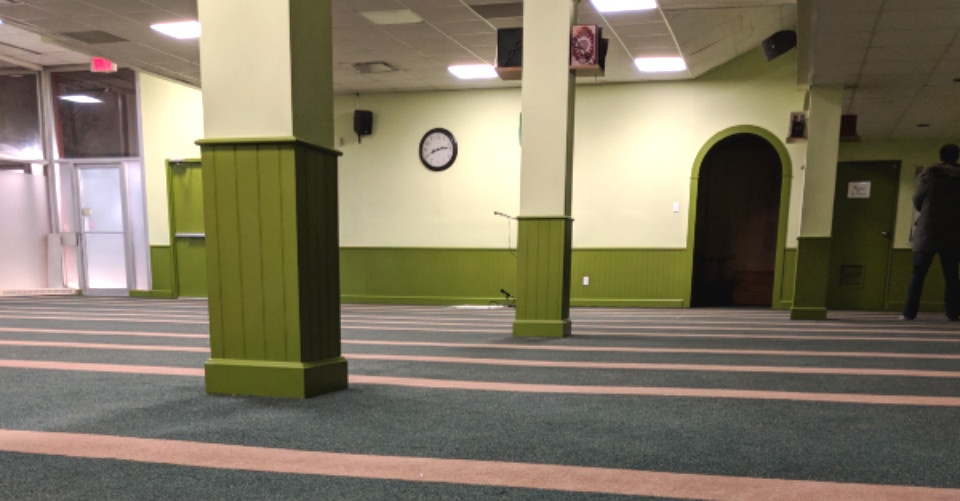
Syed Hussan is co-creator, with Imposter host Aliya Pabani, of Remember January 29 — an online memory project asking Canadians and others to mark where they were when they first heard news of the mosque shooting.
At first glance, there are no bullet holes. The light green walls show no signs. It is calm here, subdued, inviting inner quiet. The brittle, dark green carpet with soft orange rows has been washed. As I pray, my head touching the ground, I imagine the blood traces that must linger, making contact with my forehead and lips. Can you really wash out blood?
It’s the Isha prayer at the Great Mosque of Quebec City, the last of the day. As the clock ticks to 7:52 p.m. on January 4, I look around at the people still gathered, men of all ages, with scarves and jackets, mingling before they head out into the night. They speak in quiet voices, shaking hands in greeting, a soft murmur pervading the air. This is the time — 340 days earlier — that the shooting started.
I look at their faces. A realization dawns: It could have been any of them.
By 8:15, the mosque is empty. If only the murderer had been a few minutes late.
The next day, in the middle of work hours, every row is full for Friday prayers. There are hundreds of people here. Outside, it’s -25ºC, not including the wind chill; but they come, and we stand next to each other, arms and feet touching, shoulder to shoulder. We move as one. Bowing, standing, prostrating. The mosque reverberates in call and response. After the formal prayers, the imam prays for the mosque itself. It’s been nearly a year since that night. Everyone here remembers. They come so that they don’t forget.
I speak to Zeeyed Khaleel. He’s a tall man, soft-spoken, slightly bowed, with a smile always playing at his lips. Later, he will reconstruct the shooting for me. Show me the exact place where the murderer came in, extend his arm to indicate the murderer shooting the first group of people, where and how the murderer re-loaded. Point out where people hid, and how some lunged to stop him. It’s eerie watching this. He’s done it before, and he wasn’t even there. I imagine that many others in the mosque do the same. And in this collective building of a shared narrative, meaning is produced. The rest of us have yet to do that.
Zeeyed wants to know why I am here. I tell him that I am here to sit in the mosque, to just be present. I can see he’s not completely satisfied with my answer. But the truth is, I don’t really know. I’ve come to gather more questions, perhaps. Zeeyed is generous, and he doesn’t press.
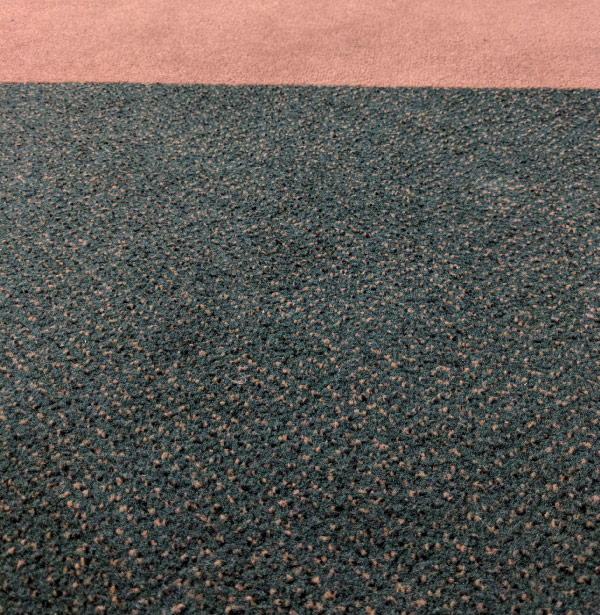
A few weeks ago, Zeeyed and other members of the mosque went to Toronto to attend Reviving the Islamic Spirit (RIS) — one of the largest Muslim conferences in North America. He created a little survey that nearly 200 attendees filled out. It asked: “What kind of a day was January 29th?” The two options: “Normal day” and “Sad day.”
The vast majority of respondents, all socially and politically engaged young Muslims, ticked “Normal day.”
For many months, I’ve laid awake with with the thoughts slowly winding through my head: Have we forgotten? Why did we forget?
Zeeyed has had the same questions: Many people outside of Quebec City have forgotten, and we don’t know why. I am quiet for a little while after he tells me about his survey, as this realization sinks in further.
There are no books written about the shooting. No art shows. No songs produced. Few poems. No monuments planned. No museums under way. Most of the major commentators and opinion writers in the country have not written about the events since they happened. Few progressive organizations have issued statements. There have been almost no discussions, no panels. No TV series have been announced. DawaNet has produced a film, but almost no other documentaries exist. Prime Minister Justin Trudeau hasn’t tweeted about the shooting since the day after it occurred. Outside of the debate on the symbolic private member’s bill to “condemn Islamophobia,” the words “Mosque Shooting” were almost never spoken in Parliament last year. It’s not just that. Canada’s largest anti-Islamophobia rally, organized by Muslims impacted by the murders, which thousands attended in the fall, didn’t even mention the shooting. There wasn’t even a single unified hashtag that we could all use; even the mosque is called different names in different accounts.
This is what collective forgetting looks like. Collective erasure. This is not a criticism of individuals: it is an examination of a structure, a pattern, and an invitation to reflect. It is as if we all decided, but unknowingly, that there was nothing else to talk about here, to see here, to unravel here, to interpret here. Not just a forgetting in the mainstream, but by activists, artists, academics, who were forgetting in public even as they may mourn in private. That somehow the murders were not part of a deeply complex, multi-generational, interlinked series of events, policies, and tragedies, but rather a single moment, soon resolved. This is collective, in that even when we know otherwise, even when we are deeply impacted, we do not speak of them.
Only when we accept that we have forgotten, and examine why and how, can we begin to do the work of re-remembering.
We are standing in the middle of the mosque, around us small groups of men with their boys; in a few cases, little girls are clustered, sitting on the floor talking. We are in between the second and third prayers of the day, and many people just decide to stay, rather than go home and return. The older men lean against the walls, laughing quietly; the younger ones check their phones. Zeeyed’s young son comes running every so often, touching his dad as if to make sure he’s still there, and then runs off. Charaf Amhaouch, one of the mosque’s volunteer organizers, joins us; he’s pushing a wheelchair with another man, Aymen Derbali. A TV camera crew begins to film us. There’s often media at the mosque, Zeeyed and Charaf explain. Mostly French, sometimes English. Why doesn’t the coverage translate into a broader conversation?
I listen to Aymen talk to a CTV journalist about not being able to go home, and needing to live in a rehabilitation center. The mosque is empty now. He’s in a wheelchair, after he tried to stop the shooting and, struck by seven bullets, became paralyzed. His house isn’t accessible, but a recent fundraiser to buy him a new home, started by DawaNet, has pushed him into the media limelight. After a year of being ignored, he’s suddenly a national hero for a few days.
I am confused about supporting the fundraiser. Why doesn’t the state pay? Shouldn’t that be our demand? Why is this about generosity and charity, and not responsibility? But also, conflicted, I’m assisting in hosting a fundraiser for him in Toronto because he can’t wait.
Aymen explains to the journalist where he was when the shooting happened. He points with his head to where I am standing at the other end of the mosque. I don’t know if this is re-traumatizing or healing for him. All I know is that Aymen can’t forget.
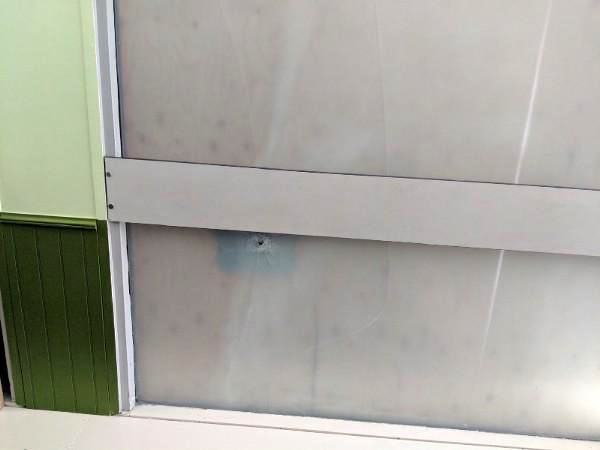
Acts of memorialization, monuments, museums, art, websites, events, reconceive societies, communities, identities. Competing narratives and tensions emerge, questions must be asked and re-asked, and in the questions, we make sense of the world anew. In the forgetting of the Quebec City Great Mosque Massacre, a political act was turned into a hate crime, and the murderer was constituted as a fascist, an aberration, rather than what he is, a representation. Most questions were pushed away.
Six men were killed on January 29, 2017. It was six specific men, but it could have been any six Muslims there. The murderer did not choose his victims; any of the Muslims were as good dead to him as any other. Six families now mourn. It could be any six. How can we remember the individuals and the collective? How do we remember them in history? How do we remember them as extensions of the murders of Muslims elsewhere in the present?
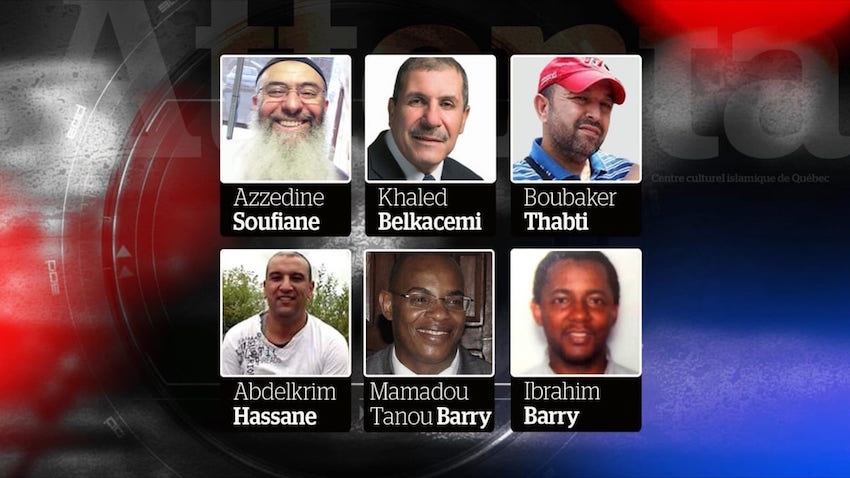
Soufiane, always smiling, ran the first halal grocery store in Quebec City. Mamadou and Ibrahima were close friends. Khaled was a professor. Aboubaker, only in Canada five years, worked at a poultry processing plant. Abdelkrim had three kids who are now growing up without a father. Six specific lives. Five others were injured: Aymen Derbali, Said El-Amari, Mohamed Khabar, Nizar Ghlai, and Said Akjour. Aymen is badly hurt, in a wheelchair, unable to move some of his limbs, bullet fragments still lodged in his spinal cord. Mohamed, a barber, can no longer work; he is unable to stand for extended periods, as a bullet went through his foot.
Algeria. Morocco. Tunisia. Guinea. Places the six murdered once called home. Places they left. But why did they? In every profile of them — and there are very few — the same words appear: “for a better life.”
Algeria — 130 years of brutal colonial French rule. And again from 2011 to 2012, the people there raged and fought once more for freedom. Morocco — over a century of colonialism, and a Western-backed monarchy with trade agreements with the U.S. and European Union. Tunisia — 75 years of French occupation, and then decades of dictatorship. Guinea — ravaged by the transatlantic slave trade, its people kidnapped by the tens of thousands, French imperialism, multinational corporations. It is the most resource-rich and yet one of the poorest countries in West Africa. Countries colonized, plundered, impoverished, forced into taking loans, their self-determination gutted. Corrupt governments propped up for the profit of global conglomerates.
Those six men killed and the five injured came here to this place called Canada, because they were pushed out of other places they called home. The murdered and the murderer did not suddenly appear before each other as if conjured outside of history. They were pulled from a tragedy, written in blood, suffering, and struggle. This tragedy had been played many times; this confrontation is centuries old.
If people do ask, they wonder how could this be avoided? But to answer that, we have to go back as much as forward. We can’t change the future without understanding the past. How can we make Muslims less replaceable, less killable in the eyes of the murderer? That would mean an end to every war against Muslims, where over and over, those bodies, our bodies, are made disposable. What would it take to ensure that no one was pushed out of their home, that everyone had the right to return?
The suspect — whose name is better known than those of the six men who were murdered — was trained as a cadet by the Canadian Armed Forces. He practised shooting at Club de tir Castors de Charlesbourg. The night of the shooting, he sat down calmly with his parents at dinner. I wonder what he ate. Did he thank his mother for the meal? Did they share a glass of wine? He allegedly picked out the guns from his mother’s basement, took his father’s car, and told them he was going to the gun range. Did they hug him goodbye? Did he kiss them? Later, she told police, he called her to say the range was closed. That’s the last she heard from him. But why did he call? Was he on the way to the range and decided to kill some Muslims because it was closed?
For many of us, the fact that he was identified, was arrested, is in prison awaiting trial is all that must be done. It is out of our hands, we say, the courts will produce justice. But no conviction will answer any of our questions, no incarceration will build a shared truth. It isn’t enough to simply say that he is a fascist misled, for every day Muslims are killed in the thousands from Syria to Somalia. Muslims are deportable, extinguishable, killable terrorists. Why wouldn’t a young man in Canada, seeing the news, think it was acceptable, perhaps even necessary, to murder?
I take a bus through the neighbourhood the suspected murderer grew up in. I don’t know his parents’ addresses, and I don’t look for them. Last April, Mohamed-Amine Ben-Faras, a relative of one of the victims, came to visit the mosque, the site of the killing. He is said to have made death threats against the suspected murderer and his family, and looked for their address. He was arrested, jailed, deported, and banned from Canada for three years. How many people have quietly thought the worst staring at the face of the suspected murderer on their screens? But only certain emotions are allowed in public. Rage is not one of them.
Through the salt-stained bus windows, I look at the identical houses lining the streets. Cars are parked, covered in snow. Here and there, families step out, wrapped up from head to toe, no skin showing in the brutal cold. Children throw snowballs. I could be anywhere in Canada. Just as the murdered could be any Muslim, could any of these families raise a murderer? Any of us could work in a factory that makes the bombs and bullets raining down on Muslims. We could make the electricity, work in the bank. It is any of us.
I change two buses to go to the gun range. Twice, I almost get off. Once, I actually do. I don’t know why I am going there or what I hope to accomplish. Along the way, I read the online reviews. Just last month, someone wrote, “Nice place to practise hot target shooting!” At least that’s what Google Translate tells me. I scroll through the reviews. How is it that no one in the place he trained has questions that they have posted online? Is it that easy to forget?
The gun range is closed. I walk around the buildings, trudging through the snow and the warehouses. I keep thinking someone is going to jump out behind me with a gun, but obviously, no one does. It was much warmer on January 29, 2017. A brisk -13ºC. But even then, I imagine the winds coming from the frozen Saint-Charles River would tear into you. I imagine the man pushing his head down, wrapping his jacket around himself, wrenching open the door. Cursing, maybe, when he found it locked. Getting back into his car and driving to the mosque to murder six Muslims. Or perhaps he lied to his mom, and never went there. Next to the range is a military surplus store. An oversized Canadian flag hangs in the window.
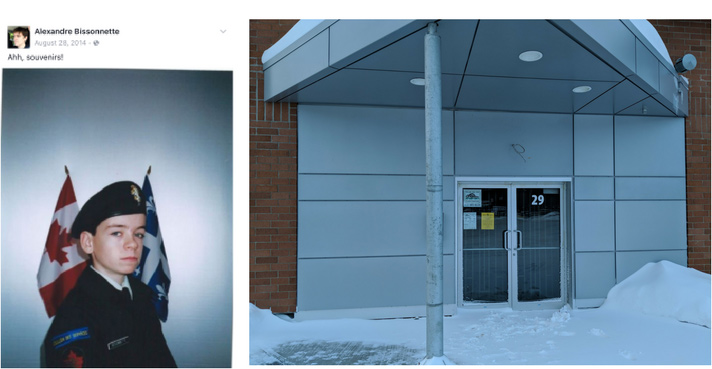
The gun range where the man practised has issued no statement. Neither have his parents, nor the Cadets or Canadian Armed Forces. Not a statement as in an apology, that is, but rather evidence of intense self-examination. Where are the myriad questions — not just where did we go wrong, but what are our interlinked histories, cultures, norms that produce the murdered and the murderers? How did the first shooting of a mosque in North America that resulted in deaths take place here? How have we forgotten?
I am leaving Quebec City. I’ve mostly cried in its streets and buses. It’s so cold and windy that no one really notices. My tears are those of grief, confusion, gratitude for those struggling, uncertainty, frustration. I didn’t coming looking for answers, and I haven’t found any.
Remembering is raging against the dying of feeling. To remember is to refuse to be numb. To remember is to remake our common humanity anew. To remember isn’t to agree but to question. To remember is to remember ourselves. Can we remember together?
Top photo of the empty mosque at 8:15 p.m. by Syed Hussan.
Correction (1/26/18, 10:15 a.m. EST): This piece originally omitted Tunisia from the list of countries from which the six men had emigrated.